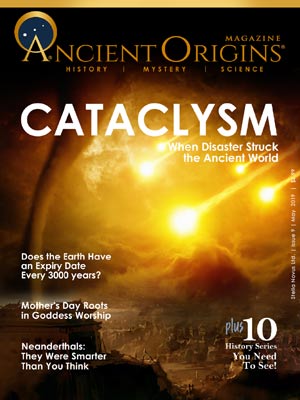
Ancient natural disasters including meteor strikes, tsunamis, volcanos, and floods had a devastating effect on the fragile psychological coping mechanisms of our forebearers. Having little external autonomy over such overwhelming cataclysmic events, they projected omnipotent power onto their gods, and believed natural disasters were punishment for personal wrongdoings or worse, the whims of peeved gods. In order not to succumb to debilitating, frantic fear, they developed rituals and sacrifices designed to appease those same gods to avert disasters and to gain some perceived sense of control. The pallet of naturally occurring phenomena was often colored with animated superhuman attributes in order to make sense of an unpredictable and dangerous world.
In this issue, we look at ten deadly volcanos – Vesuvius, Santorini, Hekla, Fuji, Krakatoa and more – which must have seemed like angry gods spewing their wrath, leaving destruction in their wake and changing the landscape forever.
Sometimes it is not only the world that changes, but our deepest faith and beliefs. Could it be that the event describing the conversion of Paul the Apostle, was, in fact, an exploding meteor? The implication would be that a cosmic phenomenon nudged Christianity in its infancy, gaining momentum over 2,000 years to become a major world religion and changing the course of history.
In yet another ancient disaster, author David Hatcher Childress proposes that Easter Island, the Lost Land of Hiva, was struck by a terrifying tidal wave that buried the famous moai statues in many layers of mud and muck, so that all we see now are their iconic heads.
We also interview associate professor Martin Sweatman, who proposes a well-grounded theory that major catastrophes, such as ancient comet impacts were recorded by ancient man, and hidden in plain sight, to act as a warning to later generations. But what of our own future? Is the Earth going to reach its ‘sell-by date’ at around 3000 AD? Evidence suggests we should at least be prepared for something big!
Humans have always recorded and feared an apocalypse or ‘end of times’ when the gods would wipe out life on earth in one fell swoop. Modern ‘preppers’ and Doomsday preachers might be surprised to learn that the world almost did come to an end in 536 AD! It was a climatic calamity of epic proportions: “The sun became dark and its darkness lasted for 18 months”.
It seems that when Mother Nature loses her cool the effects are disastrous, but May is the month that we celebrate Mother’s Day, and Martini Fisher looks at the ancient concept of the Mother goddess as an embodiment of both creation and destruction.
As a nice diversion from disaster and catastrophe, we take a fascinating look at our ancient cousins, the Neanderthals. Evolutionary biologist Clive Finlayson, Director of Excavations at Neanderthal sites in Gibraltar, breaks down decades of misperceptions about these long extinct hominids. He challenges the popular perception that so-called primitive Neanderthals were outsmarted in the evolutionary race by Modern Humans, and controversially claims they were thinking, speaking people just like you and me.
Not a member yet? Enjoy our 10-page teaser of the magazine here.
